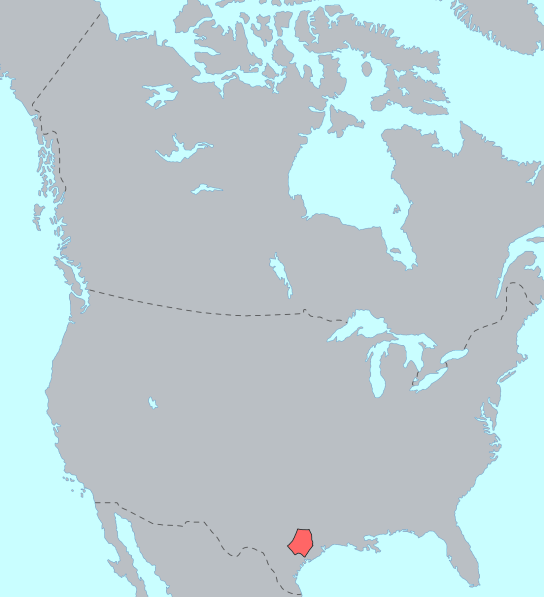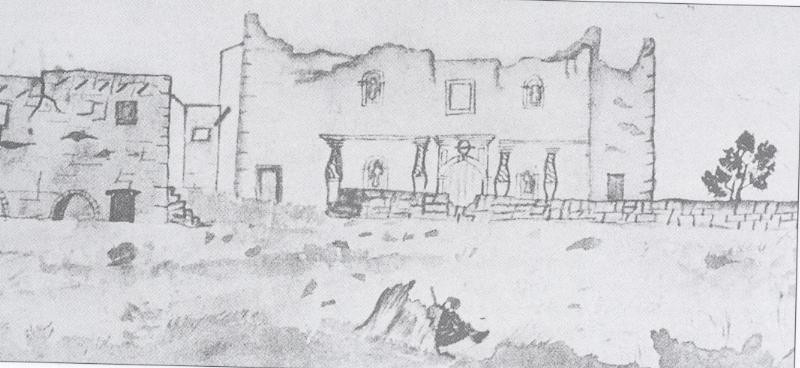|
Sijame
The Sijame were an Indigenous people of the Americas of the San Antonio, Texas region. Some historians believe they were a band of Tonkawa, but they were likely a Coahuiltecan people. Name The name ''Sijame'' translates as "fish" and has also been written as Cijame, Hijame, Xixame, and Zihame. History Spanish colonists recorded the Sijame visiting the Santo Nombre de Jesus de Peyotes Mission in 1698. The Xarame likely originated between the Nueces River and the Frio River in the Edwards Plateau. In 1699, Spanish colonists founded San Juan Bautista Mission in Coahuila to convert four Coahuiltecan bands, including the Xarame. The Spanish established another mission near present-day Eagle Pass, Texas, and some Xarame moved there. Others moved to the San Francisco Solano Mission in Coahuila, founded in 1700. In 1709, Sijame lived by San Pedro Springs near San Antonio San Antonio ( ; Spanish for " Saint Anthony") is a city in the U.S. state of Texas and the most popu ... [...More Info...] [...Related Items...] OR: [Wikipedia] [Google] [Baidu] |
Tonkawa
The Tonkawa are a Native American tribe from Oklahoma and Texas. Their Tonkawa language, now extinct language, extinct, is a linguistic isolate. Today, Tonkawa people are enrolled in the Federally recognized tribes, federally recognized Tonkawa Tribe of Indians of Oklahoma, headquartered in Tonkawa, Oklahoma. They have more than 700 tribal citizens. Name The Tonkawa's autonym is (meaning "real people"). The name Tonkawa is derived from the Waco people, Waco word, ', meaning "they all stay together". History In 1601, the Tonkawa people lived in what is now northwestern Oklahoma. They were made up of related bands. Historically, they were nomadic people, who practiced some horticulture. The Tonkawa, long thought to have been prehistoric residents of Texas, are now thought to have migrated into the state in the late 17th century. Their arrival in Central Texas is believed to have been just before or during the early European contact period. 18th century By 1700, Apache and Wi ... [...More Info...] [...Related Items...] OR: [Wikipedia] [Google] [Baidu] |
Coahuiltecan
The Coahuiltecan were various small, autonomous bands of Indigenous peoples of the Americas, Native Americans who inhabited the Rio Grande valley in what is now northeastern Mexico and southern Texas. The various Coahuiltecan groups were hunter gatherers. First encountered by the Spanish in the 16th century, their population declined due to Old World diseases and numerous small-scale wars fought against the Spanish people, Spanish, Apache, and other Indigenous groups. After the Texas secession from Mexico, Coahuiltecan peoples were largely forced into harsh living conditions. In 1886, ethnologist Albert Gatschet found the last known survivors of Coahuiltecan bands: 25 Comecrudo, 1 Cotoname, and 2 Pakawa Indians, Pakawa. They were living near Reynosa, Mexico, Reynosa, Mexico. The Coahuiltecan lived in the flat, brushy, dry country of northern Mexico and southern Texas, roughly south of a line from the Gulf Coast of the United States, Gulf Coast at the mouth of the Guadalupe River ... [...More Info...] [...Related Items...] OR: [Wikipedia] [Google] [Baidu] |
Coahuiltecan People
The Coahuiltecan were various small, autonomous bands of Native Americans who inhabited the Rio Grande valley in what is now northeastern Mexico and southern Texas. The various Coahuiltecan groups were hunter gatherers. First encountered by the Spanish in the 16th century, their population declined due to Old World diseases and numerous small-scale wars fought against the Spanish, Apache, and other Indigenous groups. After the Texas secession from Mexico, Coahuiltecan peoples were largely forced into harsh living conditions. In 1886, ethnologist Albert Gatschet found the last known survivors of Coahuiltecan bands: 25 Comecrudo, 1 Cotoname, and 2 Pakawa. They were living near Reynosa, Mexico. The Coahuiltecan lived in the flat, brushy, dry country of northern Mexico and southern Texas, roughly south of a line from the Gulf Coast at the mouth of the Guadalupe River to San Antonio and westward to around Del Rio. They lived on both sides of the Rio Grande. Their neighbors alo ... [...More Info...] [...Related Items...] OR: [Wikipedia] [Google] [Baidu] |
Mission San Francisco Solano (Mexico)
Mission San Francisco Solano was a Spanish mission established March 1, 1700 by Franciscan missionaries. Along with Mission San Juan Bautista, Mission San Bernardo, and the nearby San Juan Bautista , it belonged to a complex collectively known as the San Juan Bautista Missions. History The mission was officially founded on March 1, 1700 by Diego Ramón, with Franciscan missonaries Antonio de Olivares and Francisco Hidalgo in attendance. It was originally located from the Rio Grande in Coahuila state, northeastern Mexico, in what is today the Municipality of Guerrero. The Native American people brought into the mission belonged to various Coahuiltecan groups. The Terocodame and Xarame tribes were the most numerous; other groups present included the Jaram, Papanac, Payaguá, and Kumeyaay. Baptismal records show Payaya present by the year 1706. Later, members of the Xarame and Sijame tribes were present as well. Letters from Olivares complain of ingratitude from the mi ... [...More Info...] [...Related Items...] OR: [Wikipedia] [Google] [Baidu] |
Texas
Texas ( , ; or ) is the most populous U.S. state, state in the South Central United States, South Central region of the United States. It borders Louisiana to the east, Arkansas to the northeast, Oklahoma to the north, New Mexico to the west, and has Mexico-United States border, an international border with the Mexican states of Chihuahua (state), Chihuahua, Coahuila, Nuevo León, and Tamaulipas to the south and southwest. Texas has Texas Gulf Coast, a coastline on the Gulf of Mexico to the southeast. Covering and with over 31 million residents as of 2024, it is the second-largest state List of U.S. states and territories by area, by area and List of U.S. states and territories by population, population. Texas is nicknamed the ''Lone Star State'' for its former status as the independent Republic of Texas. Spain was the first European country to Spanish Texas, claim and control Texas. Following French colonization of Texas, a short-lived colony controlled by France, Mexico ... [...More Info...] [...Related Items...] OR: [Wikipedia] [Google] [Baidu] |
Mission San Juan Bautista (Mexico)
Mission San Juan Bautista is a Spanish mission in San Juan Bautista, San Benito County, California. Founded on June 24, 1797, by Fermín de Lasuén of the Franciscan order, the mission was the fifteenth of the Spanish missions established in present-day California. Named for Saint John the Baptist, the mission is the namesake of the city of San Juan Bautista. Barracks for the soldiers, a nunnery, the Jose Castro House, the Plaza Hotel and other buildings were constructed around a large grassy plaza in front of the church and can be seen today in their original form. The Ohlone, the original residents of the valley, were brought to live at the mission and baptized, followed by Yokuts from the Central Valley. Mission San Juan Bautista has served mass daily since 1797, and today functions as a parish church of the Diocese of Monterey. History Following its creation in 1797, San Juan's population grew quickly. By 1803, there were 1,036 Native Americans living at the missio ... [...More Info...] [...Related Items...] OR: [Wikipedia] [Google] [Baidu] |
Extinct Indigenous Peoples In Mexico
Extinction is the termination of an organism by the death of its Endling, last member. A taxon may become Functional extinction, functionally extinct before the death of its last member if it loses the capacity to Reproduction, reproduce and recover. As a species' potential Range (biology), range may be very large, determining this moment is difficult, and is usually done retrospectively. This difficulty leads to phenomena such as Lazarus taxon, Lazarus taxa, where a species presumed extinct abruptly "reappears" (typically in the Fossil, fossil record) after a period of apparent absence. Over five billion species are estimated to have died out. It is estimated that there are currently around 8.7 million species of eukaryotes globally, possibly many times more if microorganisms are included. Notable extinct animal species include Dinosaur, non-avian dinosaurs, Machairodontinae, saber-toothed cats, and mammoths. Through evolution, species arise through the process of specia ... [...More Info...] [...Related Items...] OR: [Wikipedia] [Google] [Baidu] |
Extinct Native American Tribes
Extinction is the termination of an organism by the death of its last member. A taxon may become functionally extinct before the death of its last member if it loses the capacity to reproduce and recover. As a species' potential range may be very large, determining this moment is difficult, and is usually done retrospectively. This difficulty leads to phenomena such as Lazarus taxa, where a species presumed extinct abruptly "reappears" (typically in the fossil record) after a period of apparent absence. Over five billion species are estimated to have died out. It is estimated that there are currently around 8.7 million species of eukaryotes globally, possibly many times more if microorganisms are included. Notable extinct animal species include non-avian dinosaurs, saber-toothed cats, and mammoths. Through evolution, species arise through the process of speciation. Species become extinct when they are no longer able to survive in changing conditions or against superio ... [...More Info...] [...Related Items...] OR: [Wikipedia] [Google] [Baidu] |
San Antonio De Valero
The Alamo is a historic Spanish mission and fortress compound founded in the 18th century by Catholic missionaries in what is now San Antonio, Texas, United States. It was the site of the Battle of the Alamo in 1836, a pivotal event of the Texas Revolution in which American folk heroes James Bowie and Davy Crockett were killed. Today it is a museum in the Alamo Plaza Historic District and a part of the San Antonio Missions World Heritage Site. Originally named the Misión San Antonio de Valero, it was one of the early Spanish missions in Texas, built to convert American tribes to Christianity. The mission was secularized in 1793 and then abandoned. Ten years later, it became a fortress housing the Second Flying Company of San Carlos de Parras military unit, who likely gave the mission the name Alamo ("cottonwood trees"). During the Texas Revolution, Mexican General Martín Perfecto de Cos surrendered the fort to the Texian Army in December 1835, following the Siege of Béxar. ... [...More Info...] [...Related Items...] OR: [Wikipedia] [Google] [Baidu] |





